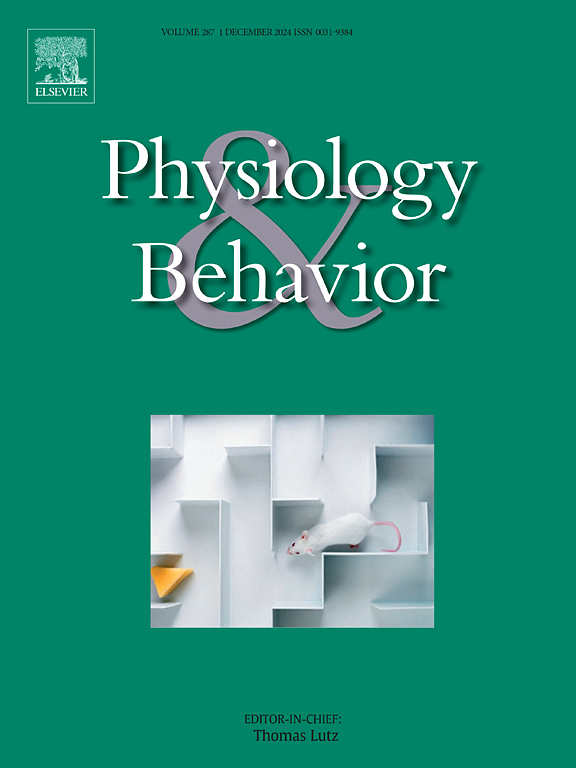Time-restricted feeding does not improve daily rhythms in locomotion and drinking disrupted by artificial light at night
IF 2.5
3区 医学
Q2 BEHAVIORAL SCIENCES
引用次数: 0
Abstract
Exposure to artificial light at night (ALAN) disrupts natural darkness and desynchronizes daily rhythms in physiological processes and behavior. Previously, in rats, we have shown that dim ALAN disturbed the central circadian control and the temporal organization of behavior, and hormonal and metabolic pathways. The measurements of undisturbed daily behavioral (locomotor activity, feeding and drinking) patterns revealed reduced amplitudes and a transitory activity peak in the middle of the light (i.e. resting) period. Recent studies indicated that time-restricted feeding during the active period (TRFd) can strengthen daily rhythms and improve metabolic health. Therefore, the aim of our study was to prevent the dim ALAN-induced attenuation of daily behavioral rhythms by applying TRFd. Male Wistar rats were kept in a 12/12 light/dark cycle in metabolic cages for one week with free access to food and water. After acclimation, rats were divided into two groups: 1) ad libitum food or 2) time-restricted food during the dark period. After one week, both groups were exposed to dim ALAN for two weeks. Despite the enhanced amplitude of the daily feeding rhythm in TRFd animals, ALAN still suppressed the rhythm of locomotor activity, induced the extra peak during the resting period and reduced the bimodal pattern during the night. Furthermore, TRFd did not prevent the drop in anticipatory thirst caused by ALAN at the end of the active period. In conclusion, TRFd was not able to fully prevent the weakning of daily behavioral rhythms by dim ALAN.
限时进食不能改善夜间受人造光干扰的日常运动和饮水节奏。
夜间暴露于人造光(ALAN)会破坏自然黑暗,使生理过程和行为的日常节奏不同步。在此之前,我们已经在大鼠中发现,暗淡的ALAN干扰了中央昼夜节律控制和行为的时间组织,以及激素和代谢途径。对未受干扰的日常行为(运动活动、进食和饮水)模式的测量显示,在光照期(即休息期)中间,振幅降低,并出现短暂的活动峰值。最近的研究表明,在活动期(TRFd)限时饲喂可以增强日常节律,改善代谢健康。因此,我们的研究目的是通过应用TRFd来预防暗淡的alan引起的日常行为节律的衰减。雄性Wistar大鼠在代谢笼中按12/12光/暗循环饲养1周,自由进食和饮水。适应后,将大鼠分为两组:1)在黑暗期随意进食和2)限时进食。一周后,两组都暴露在微弱的ALAN中两周。尽管TRFd动物每日摄食节律的振幅增强,但ALAN仍然抑制了运动活动的节律,诱导了静息期的额外峰值,并减少了夜间的双峰模式。此外,在活动期结束时,TRFd并不能阻止ALAN引起的预期口渴的下降。综上所述,TRFd不能完全阻止弱ALAN对日常行为节律的减弱。
本文章由计算机程序翻译,如有差异,请以英文原文为准。
求助全文
约1分钟内获得全文
求助全文
来源期刊

Physiology & Behavior
医学-行为科学
CiteScore
5.70
自引率
3.40%
发文量
274
审稿时长
47 days
期刊介绍:
Physiology & Behavior is aimed at the causal physiological mechanisms of behavior and its modulation by environmental factors. The journal invites original reports in the broad area of behavioral and cognitive neuroscience, in which at least one variable is physiological and the primary emphasis and theoretical context are behavioral. The range of subjects includes behavioral neuroendocrinology, psychoneuroimmunology, learning and memory, ingestion, social behavior, and studies related to the mechanisms of psychopathology. Contemporary reviews and theoretical articles are welcomed and the Editors invite such proposals from interested authors.
 求助内容:
求助内容: 应助结果提醒方式:
应助结果提醒方式:


